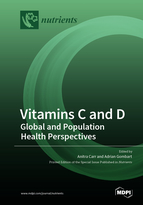Vitamins C and D: Global and Population Health Perspectives
A special issue of Nutrients (ISSN 2072-6643). This special issue belongs to the section "Micronutrients and Human Health".
Deadline for manuscript submissions: closed (30 June 2022) | Viewed by 256117
Special Issue Editors
Interests: vitamin C; intake recommendations; respiratory infections; immune function; diabetes; metabolic health; mood; cognitive health; health-related quality of life
Special Issues, Collections and Topics in MDPI journals
Special Issue Information
Dear Colleagues,
The global coronavirus pandemic has highlighted the paramount importance of immune health and the nutrient status of peoples worldwide. Vitamins C and D have important roles in both the innate and adaptive immune systems and are known to support healthy immune function. Both vitamins C and D have gene regulatory roles with the ability to up- and down-regulate thousands of genes, thus playing pleotropic roles in human health and disease. People from low- and middle-income countries tend to have inadequate micronutrient intakes and status, as do specific subgroups from high-income countries. This can affect their resistance to both communicable and non-communicable diseases and the severity of these diseases. In this Special Issue, we welcome review articles and research papers (both observational and interventional studies) that explore the role of vitamins C and D in all aspects of global health.
Assoc. Prof. Anitra CarrProf. Adrian Gombart
Guest Editors
Manuscript Submission Information
Manuscripts should be submitted online at www.mdpi.com by registering and logging in to this website. Once you are registered, click here to go to the submission form. Manuscripts can be submitted until the deadline. All submissions that pass pre-check are peer-reviewed. Accepted papers will be published continuously in the journal (as soon as accepted) and will be listed together on the special issue website. Research articles, review articles as well as short communications are invited. For planned papers, a title and short abstract (about 100 words) can be sent to the Editorial Office for announcement on this website.
Submitted manuscripts should not have been published previously, nor be under consideration for publication elsewhere (except conference proceedings papers). All manuscripts are thoroughly refereed through a single-blind peer-review process. A guide for authors and other relevant information for submission of manuscripts is available on the Instructions for Authors page. Nutrients is an international peer-reviewed open access semimonthly journal published by MDPI.
Please visit the Instructions for Authors page before submitting a manuscript. The Article Processing Charge (APC) for publication in this open access journal is 2900 CHF (Swiss Francs). Submitted papers should be well formatted and use good English. Authors may use MDPI's English editing service prior to publication or during author revisions.
Keywords
- Vitamin C
- Vitamin D
- Global health
- Low- and middle-income countries
- Recommended dietary intakes
- Infection, inflammation and immune health
- Diabetes, microbiota and metabolic health
- Mental and cognitive health
- Cardiovascular disease
- Cancer
- Prevention and treatment of COVID-19








